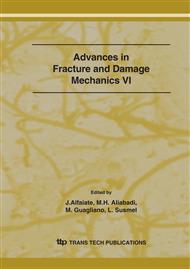p.821
p.825
p.829
p.833
p.837
p.841
p.845
p.849
p.853
Seismic Damage Model for Steel Reinforced High Strength and High Performance Concrete Frame Joints
Abstract:
Based on damage mechanics and failure model, a seismic damage model applying to steel reinforced high strength and high performance concrete frame joints is put forward, which takes deformation and cumulative damage into account. The damage performance of five tentative frame joints is compared and analyzed according to deformation and dissipated hysteretic energy under different loading levels, and the main influence factors on damage performance are established. The damage indexes of tentative frame joints are calculated, and the influence of strength grade of concrete and axial compression ratio on damage performance is discussed. The results indicate that the general damage is controlled by the damage of concrete in the earlier stage of loading, and by the damage of shape steel and stirrup in the later stage of loading; joints with lower axial compression ratio and lower concrete strength grade possess better hysteretic energy performance. Damage analysis provides an available means for the research of steel reinforced high strength and high performance concrete frame joints under seismic load. The damage model presented can be a reference for seismic damage analysis of the structure, prediction of earthquake damage in future, estimation of economic loss and repair after earthquake.
Info:
Periodical:
Pages:
837-840
Citation:
Online since:
September 2007
Authors:
Price:
Сopyright:
© 2007 Trans Tech Publications Ltd. All Rights Reserved
Share:
Citation:


